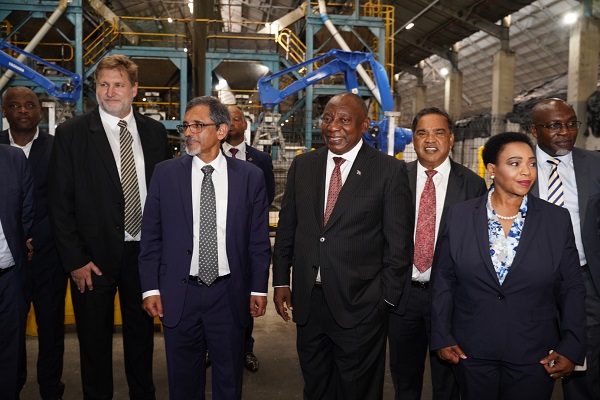Leading port logistics company, the Newlyn Group, has heeded the call of President Cyril Ramaphosa for the private sector to do more to drive SA’s growth.
In a historic launch ceremony attended by the President, the company unveiled the Newlyn PX Bayhead Rail Terminal, strategically located next to the port of Durban to open the door to enhanced intra-Africa and local trade and investment opportunities.
“This is a major milestone for SA and showcases what can be achieved when the private sector and government work together for the future of our country and her people,” declared Newlyn CEO, Raj Balmakhun.
President Cyril Ramaphosa said at the unveiling today that the completion and launch of the Newlyn Park Bayhead Rail Terminal project at the Port of Durban is not only a much-needed boost to South Africa’s logistics infrastructure network but is also a symbol of recovery and resilience for the city of Durban, for the eThekwini Metro, for KwaZulu Natal, and for the country at large. “Upgrading local port infrastructure is critical to the success of the Africa Continental Free Trade Area, and this new terminal will facilitate the swift movement of goods from South Africa to the continent and beyond,” he said.
The unveiling follows an initial investment commitment of R3.1 billion made by Newlyn following the South African Investment Conference in 2019. The development, currently valued at R3.4 billion, facilitates the movement of sea, rail, and road cargo via a multimodal hub to assist with the handling, storage, loading and movement of a variety of cargo types, including hard and soft commodities in bulk and breakbulk, containerised cargo and project cargo.
Prior to this, there was no large-scale rail and road connected facility of sufficient scale and proximity to the Port of Durban to manage the high level of flow of cargo by sea, road and rail traffic needed to unlock the North and landlocked Southern African trade corridors.
“We have updated limited and ageing infrastructure at one of Africa’s busiest ports and have drawn on international best practice in modern rail terminal design to accommodate seven block trains of 50 wagons each simultaneously. The added rail capacity accelerates the movement of cargo from road to rail, adding immense new opportunities for businesses, local economies, and supply chains,” says Firdhose Coovadia, Chief Value Officer at Newlyn.
UNCTAD says over 80% of the volume of international trade in goods is carried by sea, and the percentage is even higher for most developing countries, which makes maritime transport a strategic economic trade enabler. However, according to the AU the inadequacy of basic infrastructure has been a major factor in the lack of diversification and competitiveness of African economies, the continent’s marginalization in the dynamic sectors of regional and global trade, and its relatively low level of intra-regional trade.
“This project helps close these gaps. It drives national logistics capacity, improves global competitiveness and will help unclog bottlenecks along the critical trade corridor between Johannesburg and the port of Durban,” says Mr. Balmakhun.
The immense potential of the African Continental Free Trade Area (AfCFTA) can also be unleashed. “AfCFTA promotes industrialisation and diversification of economies by encouraging the development of regional value chains and the manufacturing sector. Congested and poorly functioning ports hold back the immense benefits of in intra-African trade, but solutions like ours ensure more trade, more industrial activity and more jobs,” says Mr. Coovadia.
Integration of local business and communities and skills transfer were critical throughout the development. As many as 4,013 direct jobs were created during construction and more than 1,000 full-time jobs have been created during the operations phase. “These jobs are growing each quarter given the ramp up of cargo through the facility,” says Mr. Balmakhun.
The facility already processes some 1,400 truck gate movements each day, handles about 380,000 tons of cargo each month, and thus is growing quarter on quarter. Commodities handled in the terminal include copper, project cargoes and equipment, cobalt, paper, fertilizer, renewable energy project cargo, zinc, and mining reagents.
The terminal comprises seven separate warehousing units (PX 1-7); four of which are on long lease to global logistics major, C Steinweg Bridge and three of the units to another global bulk logistics company, Access World. The land on which the rail terminal has been developed in leased from Transnet on long lease. The development comprises some 640,000 m2 including 350,486m2 under cover and 267,865 m2 of yard, rail siding and other infrastructure, making it one of the largest multi-modal rail terminals in the Southern Hemisphere.
It focuses strongly on ESG, boasting LED lighting, embedded rail, environmentally friendly air-cooled transformers vs oil/lead cooling systems, strategic/static ventilation to reduce energy consumption, fully compliant standalone fire system, with bulk material from demolition recycled and used as sub-base material for layerworks. The rooftop(s) can accommodate infrastructure to generate some 30MW of solar energy, adding a critical alternative green power.
Newlyn is committed to SA’s further growth. In 2023 it made a new investment pledge of a further R4 billion for the world’s first back of port manganese storage and handling facility in the Coega SEZ outside the Port of Ngqura. It has completed several projects nationally for significant players in the logistics and FMCG arenas and is involved in the development of innovative new power generation plants that will simultaneously address the power crisis and enable job creation within the country.
“Newlyn, which began operating after the dawn of democracy in SA in 1996 with passion and tenacity, is a proudly South African company with all its investments in South Africa. We are proud that all of the funding for this project is also local, making this a truly ‘made in SA’ initiative. We believe in South Africa and are ready to answer the call for action to work in a symbiotic manner with the public sector to deliver critical logistics infrastructure,” concludes Mr. Balmakhun.

.jpg)


